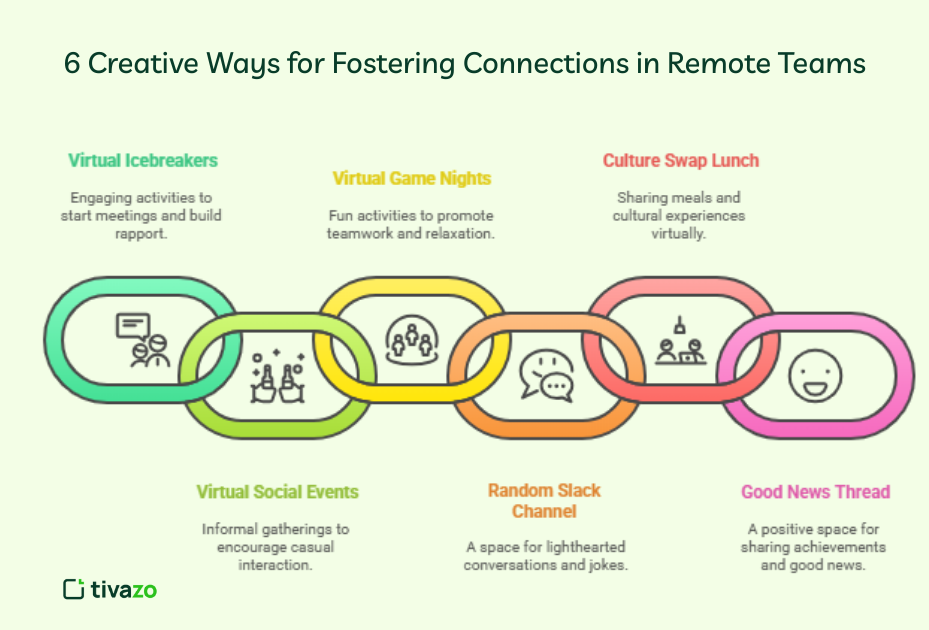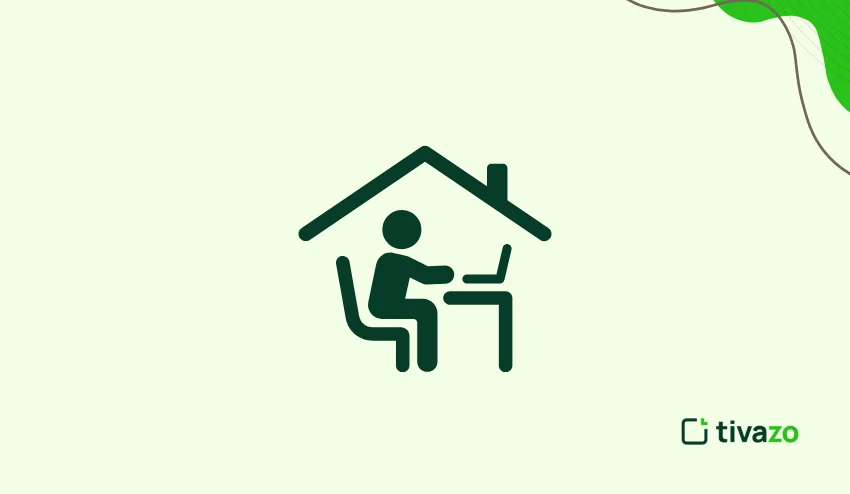Many companies are ordering staff to return to the office. HSBC is an example. It has backed off on remote work this year. Amazon, Laing O’Rourke, and Dell have also asked employees to return to work. Their reasoning? Being in the same space helps with collaboration and bonding.
To some extent, they are right. But you don’t always have to be in the same physical room to build strong connections. Fostering connections in remote teams is entirely possible when you’re thoughtful and intentional
In fact, remote work gives you the chance to be intentional about how you bring people together, rather than relying on spontaneous office interactions.
The secret sauce isn’t fancy software or expensive team retreats. It’s about creating moments where your team can be human together, laugh together, and actually get to know each other beyond their work personas.
In this piece, we’ll share a few ways to help you build connections in remote teams.

1. Kick Off Virtual Meetings with Mini Icebreakers
Going directly to business in online meetings can come across as quite cold and mechanical. Why not start them off with a bit of fun mini icebreakers? That can help foster connections in remote teams.
Ditch the standard ‘say your name and title’ greetings. Start with some enjoyable mini icebreakers instead.
“Would You Rather?” questions are great for fostering connections in remote teams and make meetings feel less robotic. They provide two simple, often amusing or thought-provoking, options. That makes it easy and fun for people to participate without feeling put on the spot.
Or, you could have everyone share a fun fact about themselves or describe their week using an emoji. Using a poll or word cloud can make it a lot more interactive for the whole group.
Not everyone loves icebreakers. Sometimes they can feel like a waste of time or forced socialization, especially if the meeting doesn’t have a clear purpose.
The key is to read the room and make sure your icebreaker fits the situation. The best approach is to keep it super short and simple and make it completely optional. It also helps if you’re brave enough to go first; it can make a huge difference in getting others to join in.
2. Host Virtual Coffee Chats and Happy Hours
In an office, people bond over small talk at the coffee machine. Remote teams miss out on that, but you can re-create it.
Virtual coffee chats and happy hours bring those moments back. The main goal of these events is to humanize team members. They help people see past job titles. They help them view a person with a life outside of work. This breaks down communication barriers and strengthens connections in remote teams.

Set aside short 15 to 20-minute coffee chats where teammates can drop in and talk about anything other than work. For something a little more fun, host a virtual happy hour. Pick a time when most people are free, invite everyone to bring their drink of choice, and keep it casual.
Keep these events short, though, with a time limit of around 30 minutes, to prevent digital fatigue. Large groups are a big no-no. Keep the group size intimate, 3 to 5 members. This makes it easier for everyone, including introverts, to come in and speak freely.
If your team members are scattered across different time zones, rotate the schedule so no one feels left out.
3. Run Virtual Game Nights
Work shouldn’t be all serious. Playing games together can bring a team closer faster than a formal meeting ever will. Game nights are a powerful tool for fostering teamwork, trust, and friendly competition. They provide a low-stakes environment for team members to interact in new ways.
Simple games like Online Pictionary, 20 questions, or a quick round of “Two Truths and a Lie” can break the ice beautifully.
If you’re looking for something slightly more challenging, why not attempt a virtual escape room or a murder mystery game? They create shared memories and build trust, all while fostering connections in remote teams in a fun, low-pressure way.
Video games can also be a great way to boost team productivity and camaraderie. A study published in ScienceDirect reveals that playing video games together builds camaraderie among team members. This helps boost team productivity.
The global phenomenon Fortnite would be an excellent choice. It offers a shared platform to play, strategize, and socialize. Be cautious, though. Oddly enough, Fortnite has been sued regarding cases of addiction. TruLaw reports that plaintiffs blame the designer for using psychological tactics to create dependency among players.
Plaintiffs in the Fortnite addiction lawsuit claim that designers use features like virtual currency, battle passes, and randomized rewards to promote excessive gameplay.
That doesn’t mean that gaming is evil. Employing it judiciously is the secret to keeping team members engaged and maintaining lasting connections in remote teams.
4. Set up a Random Slack Channel for Lighthearted Banter
Slack doesn’t have to be work all the time. Having a random or just-for-fun channel can serve as the glue that keeps team spirit intact.
That Slack channel can be a virtual office where individuals can exchange humorous memes, interesting articles, lunchtime photos, or miscellaneous thoughts. It’s where an individual can share a photo of the rainbow they observed during their morning stroll, or request Netflix suggestions.
FluentStream, a SaaS company, is a case in point. To foster connections in remote teams, the company has created plenty of channels in Slack dedicated to everything. This includes everything from fitness, music, and pets to movies and shows. These channels are great for helping people connect over shared interests and build camaraderie without any pressure.
You can definitely start these channels, but the best ones are the ones teams run themselves. When it’s peer-led, it feels way more authentic and not like a forced corporate activity. Invite everyone to share their own photos and jokes. This distributes the effort and makes building culture a team effort.
Just begin with a basic #random channel and say what it’s for. Then you can propose some particular channels by interest, such as #furry-friends or #work-soundtrack. Continue the conversation with polls and GIFs. You’ll be surprised at how these little things can make a work tool a social, fun place.
To keep it engaging, try adding recurring topics or questions. You might have a ‘Meme Monday’ where everyone posts their favorite meme. Or, a ‘Wisdom Wednesday’ for cool articles or quotes. And on Fridays, perhaps everyone can post a photo from their week. These easy concepts make it really easy for people to participate without any stress.
These concepts make it really easy for people to participate without any stress while maintaining healthy connections in remote teams.
5. Try a Culture Swap Lunch
Got a team that is spread across different cities or countries? That’s great. Companies with more ethnic diversity tend to perform better financially. In fact, research shows that those in the top 25% for diversity have a 27% average financial advantage over others.
Why not celebrate diversity? Mealtimes are a great chance to explore each other’s worlds. It makes sense to organize a culture swap lunch once in a while. These lunches combine food, storytelling, and cultural exchange in the most delicious way possible. They transform cultural differences from potential barriers into bridges for connection.
When teammates only interact for work, they might not appreciate each other’s backgrounds. This can lead to misunderstandings. A culture swap lunch provides a positive space to learn about each other’s heritage.
Each month, assign a different team member to take the lead and share something meaningful from their cultural background, hometown, or family traditions. They could teach everyone how to make a traditional dish from their heritage or share stories about local customs from where they grew up.
The person leading the session could also walk everyone through preparing a family recipe during a lunch break. Everyone else can shop for ingredients ahead of time and cook together over video.
The connections in remote teams formed during these culture swap sessions run deep because they involve personal history, family stories, and cultural pride.
6. Start a “Good News Only” Thread
Social media feeds and newspaper headlines are often filled with negativity. It’s not without reason.
Research published in Nature shows that negative wording in headlines can boost click-through rates by about 2.3%. In other words, bad news grabs attention. But constantly consuming negativity can weigh people down, especially when working remotely.

Amidst all the negativity, a “Good News Only” thread can be a refreshing way of fostering connections in remote teams. The idea is simple: create a dedicated Slack or Teams channel where only uplifting updates are shared.
These can be personal wins like completing a marathon, celebrating a pet’s birthday, or even mastering a tricky recipe. They can also be work-related victories such as landing a new client, finishing a big project, or receiving great feedback from a customer.
What makes this powerful is how contagious positivity becomes. One person’s happy news often sparks cheers, emojis, and more good news from others. Over time, this thread evolves into a digital sunshine board, a safe corner to scroll through when stress runs high.
To keep the positivity flowing, you could introduce weekly prompts, lighthearted contests, or spotlight a “Good News Champion” each month.
Fostering Connections in Remote Teams Takes Intention
Managing a remote team doesn’t mean resigning yourself to a culture of isolation. You can build a remote work environment where your team feels valued, energized, and truly connected with these creative ideas.
Keep one thing in mind, though. The goal isn’t to force friendships but to create opportunities for authentic relationships to grow. When people feel connected, they are not just more productive, but also happier, more engaged, and far more likely to stick around for the long haul.
So, which of these ideas will you try first? Whatever you choose, rest assured that it will foster connections in remote teams and transform the way your team experiences remote work.




